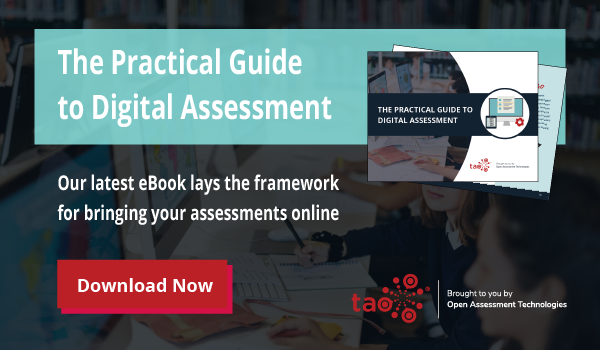Educators are continually evolving course curriculum, class activities, and assessments to better align with student needs and improve learning outcomes across classes. Teachers use various assessment models to effectively adapt their coursework to their students, such as formative assessments.
Formative assessments are low-stakes, qualitative tests that monitor student learning throughout a course. While these assessments typically have no point value, they offer critical learning insights that help teachers adjust course curriculum and activities based on their students’ strengths and weaknesses.
The most valuable, insightful formative assessments use the power of personalization to capture the most accurate measures of each student’s mastery of a subject, concept, or recent class activity. Personalized assessments keep students engaged in course material and give each child an equitable experience through assessments that target their ideal learning style and life experiences.
In this post, we’ll highlight the power of personalization in formative assessment and share four techniques for creating personalized assessments that engage students and deliver the best insights for teachers.
Personalization in Formative Assessment
Since educators use formative assessments to understand student mastery, accurate results and insights are critical. If students find ways to ‘beat’ generic multiple-choice questions with the process of elimination, testing tricks, or sheer luck, both parties suffer. Formative assessments inform teaching strategies and help students look introspectively at their understanding and comfort with various concepts and course subjects.
Personalization is the foundation of formative learning. Personalized assessments that use tools like A.I. or adaptive technology can offer valuable insights for teachers and, in turn, create better learning outcomes for students.
How To Keep Students Engaged with Personalized Assessments
#1 Set Clear Goals
As you finalize course materials, including formative and summative exams, consider not only what you’re including but why. Tie each lesson, assessment, activity, etc., back to a specific learning or teaching goal.
Instead of setting goals like “I want every student to pass this class,” tie your goals to a learning outcome, such as, “I want every student to be able to identify all seven continents on a map.”
You can set and apply key learning outcomes for the course as a whole, but you should also create goals for each formative assessment along the way. When setting goals for a formative assessment, consider both learning and teaching goals:
- Learning goal: Every student can complete a word problem related to multiplication and show their work step-by-step on the page.
- Teaching goal: I can adjust next week’s lesson based on the aspects of multiplication my students struggled with during this assessment.
Clear, measurable goals will help keep students on track and ensure each formative assessment helps you adapt course materials appropriately. It’s also important to share learning goals with your students so they can reflect on their own. When students understand why they’re practicing a particular concept or end-goal, they’re likely to be more motivated, engaged, and thoughtful in and out of class.
#2 Encourage Open Communication
Communication is the key to engagement, no matter the setting. In school, one of the best ways to keep your students engaged is through routine, conversational communication. Make your students integral players in the teaching, learning, and assessment process by establishing an open feedback culture in and out of class.
Leave feedback on formative assessments and keep communication lines open — encourage students to connect with you to go over your comments on their work or raise concerns if they don’t understand some of the feedback. This means implementing a digital feedback tool into your assessment software for remote students so that students see more than just which questions they missed. Look for a tool that allows back-and-forth commenting on assessments so students can respond or ask questions.
While teacher-student communication is critical, it’s not the only way to keep students engaged. A successful feedback culture should move in multiple directions: student-teacher, teacher-teacher, student-student, etc.
Establish easy, low-pressure ways to keep students in touch no matter where or how they participate in class. Use message boards or in-class exercises to spark student discussions on various subjects. Students can put their heads together to understand multiple perspectives, identify new solutions, and practice their communication skills. You can even implement AR/VR-based tools that simulate social media platforms and other similar media where students can complete tasks and offer feedback on each other’s posts.
#3 Give Students Authentic Tasks
Whether students test at-home or in-person, authentic assessments are the key to better learning outcomes. Authentic tasks use personalization to promote engagement give you valuable insights into what your students know about a subject.
When creating formative assessments, include authentic testing materials that empower students, measure critical thinking skills, and give you a qualitative understanding of student performance. Since these assessments aren’t for a grade anyways, steer clear of legacy curriculum and multiple-choice or true/false questions in favor of free response and interactive questions that ask students to do things like:
- Summarize the main points of the lesson
- Draw a graph, outline, or map
- Explain how they would apply concepts from the lesson to a ‘real’ situation
Authentic tasks may leverage adaptive technology that adjusts each exam question based on previous responses. Or maybe you harness the power of A.I. to create real-world situations where students demonstrate their skills, such as mixing chemicals in a lab or identifying various plants in a virtual garden. These tools encourage student engagement and long-term retention while also equipping teachers with detailed insights they can leverage to update or improve future lessons.
#4 Unify Toolsets
With students working in-class, online, or with a hybrid mix of the two, consistency is a more significant challenge for teachers than in years past. As you create formative assessments for students in various learning environments, interoperability plays a critical role in successfully uniting students and fellow educators behind a single source of truth.
Implement an all-in-one assessment tool where you can create assessments and record results across classes. Even your in-person students can use a digital platform to submit their responses and review your feedback on their work. With every student working on compatible tools, you save significant time and effort manually grading, recording, and aggregating results.
As you work to create a consistent assessment process for each student, you’ll also strengthen your data insights on the backend with a system that automatically records metrics related to student performance and engagement. You can also set up automated proctoring to assess how well students engage with tests or reporting tools to automatically identify trends between classmates or classes as a whole.
—
Formative assessments are invaluable tools for educators and students alike. As you begin introducing or optimizing these evaluations, consider how a digital assessment platform like TAO can empower students and enable teachers to promote better learning outcomes across your organization. Our Practical Guide to Digital Assessment offers a deep dive into which features matter most when implementing a new toolset.

